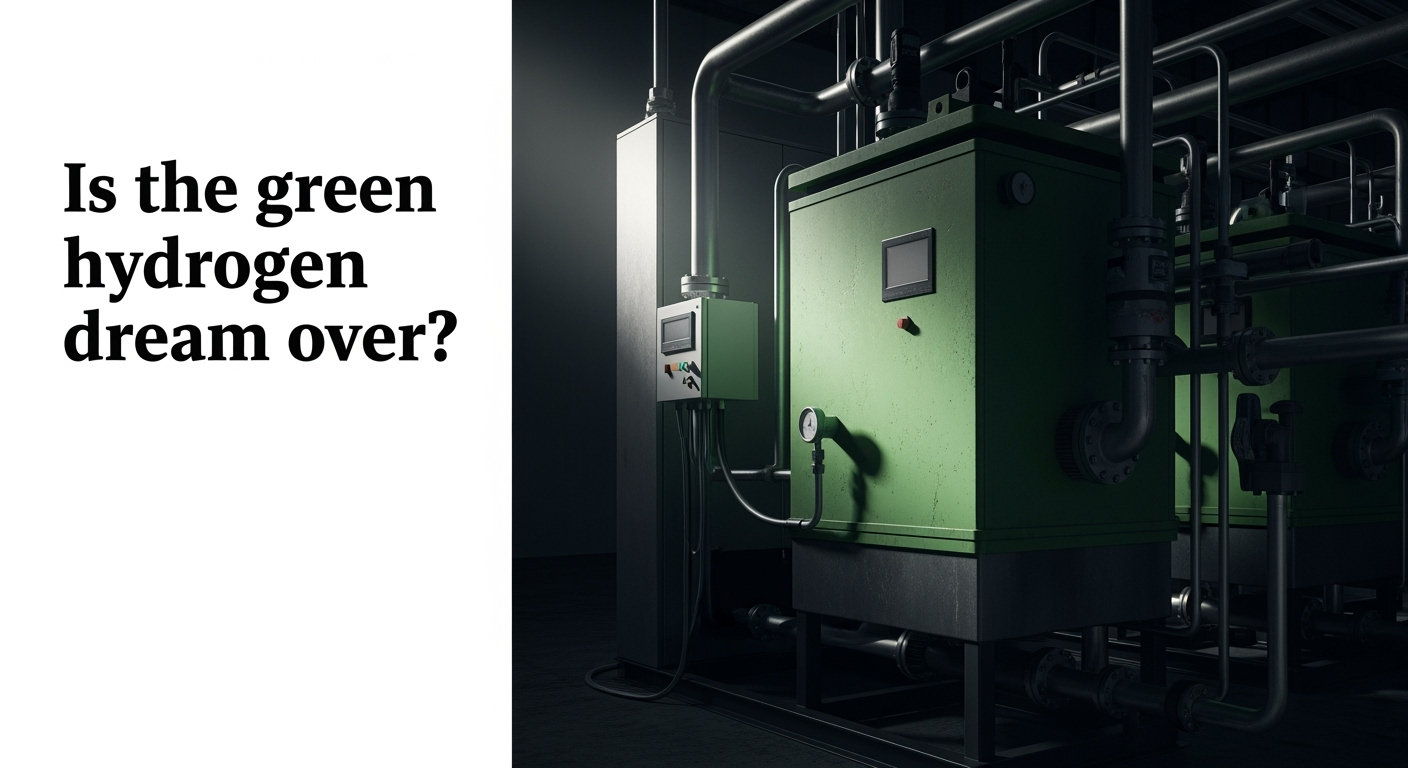Related Articles

The Unseen Costs: Dissecting the Dark Side of Viral Food Trends

Solar's Bold Horizon: Powering Earth and Beyond in a New Energy Era





The promise of green hydrogen, once hailed as a universal panacea for global decarbonization, is facing a rigorous reality check. After years of fervent enthusiasm and ambitious project announcements, a wave of cancellations and delays has forced a reevaluation of its role in the clean energy transition. This shift signifies not an end to the "green hydrogen dream," but rather a maturation of the market, moving from broad-stroke hype to a more focused, strategically targeted approach for the world's most challenging emissions.
Green hydrogen, produced by splitting water into hydrogen and oxygen using electricity generated solely from renewable sources like wind or solar, emerged as a beacon of hope in the fight against climate change. Unlike grey hydrogen (derived from natural gas with significant carbon emissions) or blue hydrogen (which incorporates carbon capture), green hydrogen offers a truly carbon-free energy carrier, emitting only water vapor when used as fuel. Its versatility captivated policymakers and industry leaders alike.
Proponents envisioned green hydrogen as the "silver bullet" capable of decarbonizing sectors historically deemed "hard-to-abate," where direct electrification is challenging or impractical. These include heavy industries such as steel, cement, and chemical production, particularly ammonia synthesis. It also held immense potential for long-haul transportation, powering fuel cell electric vehicles (FCEVs), trucks, trains, shipping, and even aviation through hydrogen-derived synthetic fuels. Furthermore, green hydrogen was identified as a crucial element for long-term energy storage and grid balancing, allowing surplus renewable energy to be stored and redeployed as needed, thereby mitigating the intermittency of wind and solar power. This expansive vision sparked a global gold rush, with companies announcing multibillion-dollar projects and gigawatt-scale ambitions.
Despite the clear environmental benefits, the economic and logistical realities of large-scale green hydrogen deployment have proven to be formidable. The primary challenge lies in its prohibitive production cost. Green hydrogen currently ranges from $4 to $12 per kilogram (kg), making it significantly more expensive than its fossil fuel-derived counterparts; grey hydrogen averages $1 to $3 per kg, while blue hydrogen sits between $2 and $5 per kg, even reaching $7 to $11 in some regions. This "green premium" is largely attributed to the capital-intensive nature of electrolyzer technology and the high cost of the renewable electricity required to power it.
Beyond production costs, the infrastructure demands present substantial hurdles. Hydrogen, a tiny molecule, has a low energy density, making storage and transportation complex and expensive. It requires either extreme compression or cryogenic liquefaction, both of which are energy-intensive processes that add to the overall cost and complexity of the supply chain. Moreover, existing energy infrastructure, such as pipelines and refueling stations, was not designed for hydrogen, requiring costly retrofitting or entirely new construction. The potential for hydrogen embrittlement in certain materials also raises safety concerns and necessitates specialized equipment.
A critical barrier has been the "offtake impasse" – a significant gap between the optimistic projections for production and the actual market demand for green hydrogen. Many projects have struggled to secure long-term purchase agreements (offtake agreements) at commercially viable prices, leading to financial unfeasibility. The limited current usage of low-emissions hydrogen, which accounted for a mere 0.7% of total hydrogen consumption in 2023, underscores this demand uncertainty.
The confluence of high costs, infrastructure challenges, and weak demand has triggered a substantial market correction. The period from 2023 through mid-2025 has seen an unprecedented wave of project cancellations, postponements, and scaling-back of ambitions across the globe.
In the United States, projects like Clean Hydrogen Works in Louisiana and some of Air Products' facilities faced setbacks due to the loss of tax credits and regulatory issues. Hy Stor Energy canceled a significant electrolyzer capacity reservation in Mississippi, citing market headwinds and financial unfeasibility. European projects have also been impacted; Shell scrapped a low-carbon hydrogen plant in Norway due to lack of demand, while BP exited an Australian project. Iberdrola, a major European utility, drastically reduced its 2030 green hydrogen production target by approximately two-thirds, from 350,000 tons to 120,000 tons, due to financing delays. ArcelorMittal abandoned plans to convert two German steel plants to green hydrogen, even returning €1.3 billion in government subsidies, citing high energy costs and funding delays.
Australia, initially a strong proponent of green hydrogen, has also experienced significant pullbacks. Woodside Energy shelved two projects, Trafigura abandoned a A$750 million plant, and the Queensland government withdrew funding for a A$12.5 billion project. Even a major German-Australian deal between Fortescue and E.On, once hailed as a landmark agreement for green hydrogen supply to Europe, collapsed, with E.On deprioritizing large-scale green hydrogen investments. Jun Sasamura, hydrogen manager at Westwood Global Energy, estimates that only 17% of the European Union's planned hydrogen projects will be realized by 2030, highlighting a widening gap between ambition and reality. Policy uncertainty, particularly regarding the longevity and eligibility criteria of government incentives like the U.S. 45V tax credit, has created an unstable investment climate for capital-intensive projects.
Despite these significant setbacks, industry experts and governments maintain that the "green hydrogen dream" is not over; rather, it is evolving. The current period is seen as a necessary market recalibration, moving away from speculative, broad-based ambitions toward more pragmatic and strategically sound applications.
The focus is shifting toward "high-impact" applications in hard-to-abate sectors where green hydrogen offers one of the few viable pathways to decarbonization. These include its use as a feedstock in chemical processes (e.g., ammonia production for fertilizers), as a reducing agent in steel manufacturing (e.g., green iron), and in heavy-duty transport where batteries are less efficient or practical. In these niches, the environmental benefits of green hydrogen outweigh its current cost premium.
Crucially, experts anticipate significant cost reductions in green hydrogen production over the coming years. Projections suggest the average cost could decrease to $2.5 per kg by 2030, and potentially as low as $1 per kg by 2050, driven by technological advancements in electrolyzer efficiency, economies of scale, and falling renewable energy prices. Governments worldwide continue to support the sector; more than 60 countries have published hydrogen roadmaps, and commitments totaling at least $275 billion have been earmarked for clean hydrogen by March 2025. India, for instance, aims to reduce green hydrogen costs to $1 per kg and achieve 5 million metric tons of production by 2030. The Inflation Reduction Act in the U.S. also provides production tax credits intended to stimulate investment.
Strategic partnerships between governments, industry players, investors, and the scientific community are considered critical to overcoming the remaining obstacles, particularly in scaling up electrolysis capacity, expanding renewable energy infrastructure, and developing robust storage solutions.
The narrative around green hydrogen is undeniably shifting. The initial, almost boundless optimism has given way to a more sober and realistic assessment. The widespread project cancellations and scaling back of targets represent a painful but essential market correction, distinguishing viable pathways from over-ambitious speculation.
The green hydrogen dream is not over, but it is undergoing a profound transformation. Instead of a universal solution, it is being refined into a critical, targeted tool for specific decarbonization challenges. Its future hinges on continued technological innovation, substantial cost reductions, the establishment of clear policy frameworks, and the strategic development of infrastructure tailored for its most impactful applications. While the road ahead remains challenging, the role of green hydrogen as an indispensable component of a net-zero future, particularly in hard-to-electrify industries, is becoming increasingly clear and focused.